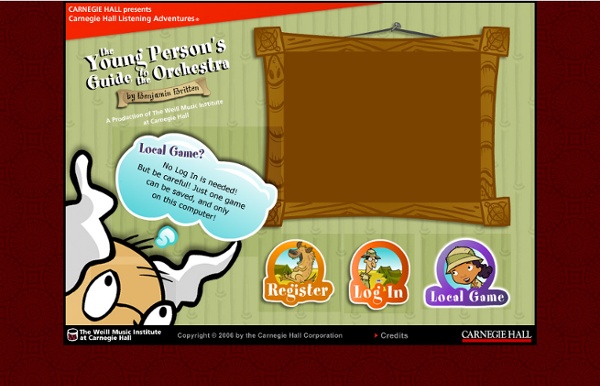



Instrument Lab | ArtsAlive.ca Music Tweak, tinker and listen to all your favourite instruments! Explore! Listen! Enjoy! What's In An Orchestra? Orchestras are comprised of instruments from four different sections: Begin by learning about the whole orchestra... An orchestra is a group of musicians playing different musical instruments under the direction of a conductor. In this Instrument Lab you can listen to and "virtually" handle all the instruments of the orchestra. The NAC Orchestra The National Arts Centre Orchestra specializes in the music of the Classical Period. That is only about one half the number of instruments in the full-sized Vancouver, Toronto and Montreal symphony orchestras. The String Section has 20 first violins, six violas, seven cellos, and five double basses, and one harp.
Sounds Historic About Age range: Good for 10-13 year olds Estimated Time: Give yourself some time! Key Technology: You will need speakers (or headphones) for the music parts, Flash Player version 10 or higher, and Adobe Reader. This interactive site explores how music is inspired by history, makes history itself, or captures an important place and time. Think About... Don’t forget to try the listening activities for each of the pieces! Listen to Russell Nadel’s finished composition. Did You Get It? What are the three things that Russell Nadel says that a new composition needs to be? Think About It! Can you think of any other pieces of music that are influenced by history? What’s Your Take? What historic event would inspire you to write a piece of music? next: Learn More > < previous: About Learn More Try It Yourself! Compose your own music on these great sites: For the Educator Trying to spice up a history lesson? Instructional Strategies Have students discuss what they know about composers.
NAC Orchestra and Friends | ArtsAlive.ca Music Learn all about Pinchas Zukerman and National Arts Centre Orchestra (NACO)...plus their conductor and composer friends! Musicians, conductors and composers in our interviews offer great information and advice on better playing, practicing and enjoyment of music. Many of them also demonstrate their instruments! String Musician Interviews Walter Prystawski, National Arts Centre (NAC) Orchestra founding concertmaster (retired) Amanda Forsyth, NAC Orchestra, principal cello Woodwind Musician Interviews Joanna G'froerer, NAC Orchestra, principal flute Charles Hamann, NAC Orchestra, principal oboe Kimball Sykes, NAC Orchestra, principal clarinet Brass Musician Interviews Karen Donnelly, NAC Orchestra, principal trumpet Julie Fauteux, NAC Orchestra, associate principal horn Donald Renshaw, NAC Orchestra, principal trombone Percussion Musician Interviews Ian Bernard, NAC Orchestra, principal timpani Jonathan Wade, NAC Orchestra, percussion Ken Simpson, NAC Orchestra, percussion
Using Music in the ESL Classroom Music is the universal language of mankind.Henry Wadsworth Longfellow When students make a major breakthrough in learning, it is music to a teacher's ears. There is nothing more rewarding for a teacher, than seeing their students smile and laugh while they learn. The same can be said for students. Students who are taught in a fun and creative way, love coming to class. Using music in the classroom is a great way for teachers to achieve success with L2 learners. Benefits of using Music Have you ever heard of anyone who doesn't like music? "Music stabilizes mental, physical and emotional rhythms to attain a state of deep concentration and focus in which large amounts of content information can be processed and learned." Techniques for Using Music with L2 Learners There are a variety of different ways to use music in the classroom. Suggested Activities Many teachers try using music once in the class, but forget to do it again. Teaching Kids with Music Tips for Using Music Effectively
Listen to the Oldest Song in the World: A Sumerian Hymn Written 3,400 Years Ago In the early 1950s, archaeologists unearthed several clay tablets from the 14th century B.C.E.. Found, WFMU tells us, “in the ancient Syrian city of Ugarit,” these tablets “contained cuneiform signs in the hurrian language," which turned out to be the oldest known piece of music ever discovered, a 3,400 year-old cult hymn. Anne Draffkorn Kilmer, professor of Assyriology at the University of California, produced the interpretation above in 1972. (She describes how she arrived at the musical notation—in some technical detail—in this interview.) The piece, writes Richard Fink in a 1988 Archeologia Musicalis article, confirms a theory that “the 7-note diatonic scale as well as harmony existed 3,400 years ago.” Kilmer and Crocker published an audio book on vinyl (now on CD) called Sounds From Silence in which they narrate information about ancient Near Eastern music, and, in an accompanying booklet, present photographs and translations of the tablets from which the song above comes.